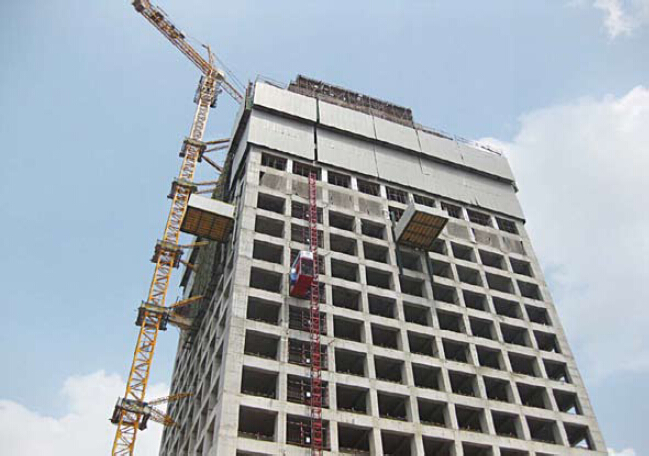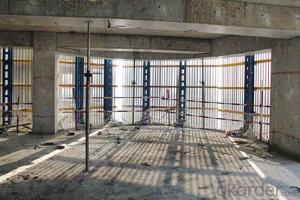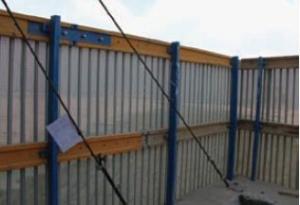Protection-Platform for Formwork and scaffolding systems
- Loading Port:
- Tianjin
- Payment Terms:
- TT OR LC
- Min Order Qty:
- 50 m²
- Supply Capability:
- 1000 m²/month
OKorder Service Pledge
OKorder Financial Service
You Might Also Like
Protection Platform PP-50
A kind of new type construction protection system, applying operating platform and safer job
location for construction corps.
Characteristics:
◆ Easy and quick assembling.
◆ Lifted as a group, it is rapid and economic.
◆ Auto-climbing
◆ A safe and reliable anchor system
1. Composition
2. Assembly process of anchor system
(1) Embed V-climbing cone and anchor plate into the slab.
(2) Fix anchor shoe on the slab by tensile bolt.
(3) The fixed anchor shoe.
◆ High work efficiency with work platform and unload platform
◆ High light transmittance with the hollow block


- Q:How does steel formwork handle formwork stripping time?
- Steel formwork is known for its durability and strength, which makes it highly efficient in handling formwork stripping time. Unlike traditional wooden formwork, steel formwork can withstand multiple uses without compromising its structural integrity. This means that the stripping time for steel formwork is significantly reduced compared to other formwork materials. Due to its rigid construction, steel formwork can support the weight of concrete and resist deformation during the pouring and curing processes. This allows for faster stripping of the formwork after the concrete has set, as there is less concern about damaging or warping the formwork. Additionally, steel formwork is designed to have smooth and non-porous surfaces. This characteristic prevents the concrete from adhering to the formwork, making the stripping process even easier and quicker. The smooth surface also contributes to a better finish of the concrete, reducing the need for additional finishing work. Moreover, steel formwork systems often incorporate adjustable features, such as adjustable props and modular panels. These features enable the formwork to be easily adjusted and repositioned, further enhancing the efficiency of the stripping process. This adaptability allows for faster stripping and reusability of the formwork, resulting in significant time and cost savings. In conclusion, steel formwork handles formwork stripping time exceptionally well due to its durability, strength, and smooth surface. Its ability to withstand multiple uses, resist deformation, and prevent concrete adhesion makes steel formwork highly efficient and time-saving in the construction industry.
- Q:Can steel formwork be used for underground parking structures?
- Yes, steel formwork can be used for underground parking structures. Steel formwork provides a strong and durable solution for constructing the walls, columns, and slabs of underground parking structures. It offers several advantages such as high strength, flexibility, and the ability to withstand the pressure exerted by the soil and water in underground conditions. Steel formwork also allows for faster construction compared to traditional formwork systems, as it can be easily assembled and disassembled, and it requires minimal maintenance. Additionally, steel formwork is reusable, making it a cost-effective choice for underground parking structures. Overall, steel formwork is a suitable and efficient option for constructing underground parking structures.
- Q:How does steel formwork affect the overall long-term performance of the structure?
- The overall long-term performance of a structure can be significantly influenced by the use of steel formwork. One of the main advantages of steel formwork is its durability, as steel is a robust and resilient material that can endure heavy loads and extreme weather conditions, thereby ensuring the structure's longevity. The utilization of steel formwork provides a rigid and stable framework for pouring concrete. This, in turn, leads to a more precise and accurate construction process, ultimately resulting in a stronger and higher quality structure. Moreover, steel formwork allows for quicker construction as it can be easily assembled and disassembled, reducing the overall construction time. Additionally, steel formwork offers a smooth and flat surface finish, which is vital for the aesthetic appeal of the structure. The smooth surface reduces the need for additional finishing work, saving both time and money. Furthermore, the use of steel formwork guarantees proper support and reinforcement for the concrete, preventing issues such as cracking, sagging, or deformation over time. Another advantage of steel formwork is its reusability. Unlike traditional wooden formwork, steel formwork can be used multiple times, resulting in cost savings and a reduced environmental impact. The durability and strength of steel formwork enable it to endure the wear and tear of multiple uses, making it a more sustainable option. To summarize, steel formwork has a positive impact on the overall long-term performance of a structure by providing durability, strength, accuracy, and reusability. It ensures a construction process of high quality, resulting in a robust and aesthetically pleasing structure that can withstand the test of time.
- Q:Can steel formwork be easily transported to different job sites?
- Yes, steel formwork can be easily transported to different job sites. Steel formwork is known for its durability and strength, making it suitable for repeated use and easy transportation. It can be disassembled and reassembled without losing its structural integrity, allowing it to be easily transported to different locations. Additionally, steel formwork is lightweight compared to other types of formwork, making it easier to handle and transport using regular construction machinery or vehicles. Its versatility and transportability make steel formwork a popular choice for construction projects that require frequent movement between job sites.
- Q:What are the common design considerations for steel formwork systems?
- There are several common design considerations for steel formwork systems that should be taken into account to ensure the successful construction of a project. Firstly, the load-bearing capacity of the steel formwork system is a crucial consideration. The formwork must be able to safely support the weight of the concrete being poured and any additional loads such as workers or equipment. This requires careful calculation and analysis to determine the appropriate thickness and reinforcement of the steel formwork. Secondly, the formwork system should be designed to provide adequate stability and resistance against lateral forces. This is particularly important in high-rise or complex structures where wind or seismic loads may be significant. The design should incorporate bracing and anchorage systems to ensure the formwork remains stable during construction. Another important consideration is the ease of assembly and disassembly of the steel formwork system. The design should allow for efficient installation and removal, minimizing labor and time requirements. This often involves the use of modular components and standardized connections that can be easily assembled and dismantled. Additionally, the formwork system should be designed to accommodate any necessary adjustments or modifications. Construction projects often require changes or adaptations during the construction process, and the formwork should be flexible enough to accommodate these changes without compromising structural integrity. Furthermore, safety considerations play a vital role in the design of steel formwork systems. The formwork should be designed to provide a safe working environment for construction workers, with features such as handrails, access platforms, and non-slip surfaces. Additionally, the design should consider potential hazards, such as sharp edges or protruding elements, and incorporate appropriate safety measures to mitigate these risks. Lastly, the durability and longevity of the steel formwork system should be taken into account. It should be designed to withstand the harsh conditions of construction, including exposure to weather, chemicals, and repeated use. This may involve the use of corrosion-resistant materials or protective coatings to ensure the longevity and performance of the formwork system. In conclusion, the common design considerations for steel formwork systems include load-bearing capacity, stability against lateral forces, ease of assembly and disassembly, adaptability to changes, safety features, and durability. By carefully considering these factors, engineers can design a steel formwork system that meets the specific requirements of a construction project and ensures its successful execution.
- Q:Can steel formwork be used for dam construction?
- Yes, steel formwork can be used for dam construction. Steel formwork is strong, durable, and can withstand the high pressure exerted by the water in dams. It provides a stable and secure framework for pouring concrete and ensuring the structural integrity of the dam. Additionally, steel formwork can be reused multiple times, making it a cost-effective choice for dam construction projects.
- Q:How does steel formwork contribute to the speed of construction?
- There are several ways in which steel formwork speeds up construction. Firstly, steel is a strong and durable material, allowing for faster construction as it can withstand the pressure and weight of the concrete. This means that larger formwork sections can be used, reducing the number of components and speeding up assembly. Secondly, steel formwork is highly reusable. Unlike timber formwork, it can be used for multiple projects, saving time and resources. It can also be easily assembled and disassembled, allowing for faster turnaround times. In addition, steel formwork is adaptable and customizable, fitting different shapes and sizes. This eliminates the need for custom-made formwork, which is costly and time-consuming. Furthermore, steel formwork is resistant to weather conditions, unlike timber formwork. This allows construction to continue even in adverse weather, minimizing delays and maintaining speed. Lastly, steel formwork provides a smooth finish to the concrete structure, eliminating the need for additional finishing work like plastering or sanding. In conclusion, steel formwork speeds up construction by being durable, reusable, adaptable, weather-resistant, and providing a smooth finish. These factors combine to reduce construction time, improve efficiency, and accelerate the overall process.
- Q:How does steel formwork compare to timber formwork?
- Steel formwork is generally considered to be superior to timber formwork in terms of durability, strength, and reusability. Steel formwork has a longer lifespan, can withstand higher pressures and loads, and requires less maintenance compared to timber formwork. Additionally, steel formwork provides better dimensional accuracy and consistency, resulting in smoother and more uniform concrete surfaces. While timber formwork may be less expensive and easier to handle, steel formwork offers numerous advantages that make it a preferred choice in many construction projects.
- Q:Can steel formwork be used for both large and small construction projects?
- Yes, steel formwork can be used for both large and small construction projects. Steel formwork offers several advantages such as durability, strength, and reusability, which make it suitable for a wide range of projects. For large construction projects, steel formwork provides the necessary structural support to handle heavy loads and withstand the pressures of large-scale construction. Additionally, its ability to be easily assembled and disassembled allows for efficient construction processes. On the other hand, for small construction projects, steel formwork offers cost-effectiveness and flexibility. Its reusability allows for multiple uses, minimizing the need for additional formwork materials and reducing construction costs. Overall, steel formwork is a versatile option that can be adapted to meet the requirements of both large and small construction projects.
- Q:How does steel formwork handle formwork reuse and recycling?
- Steel formwork possesses exceptional durability and strength, making it highly appropriate for the reuse and recycling of formwork. One of the primary advantages of steel formwork lies in its capacity to endure numerous uses without compromising its structural integrity. Unlike alternative formwork materials such as timber or plywood, steel formwork can be effortlessly cleaned, mended, and refurbished for subsequent projects. In terms of formwork reuse, steel formwork provides notable cost savings. Its extended lifespan permits multiple reuses, reducing the necessity for frequent replacement and consequently minimizing material and labor expenses. This renders it a more sustainable and economical option compared to disposable formwork materials. Furthermore, steel formwork necessitates less maintenance and repair, thereby contributing further to its efficiency and overall cost-effectiveness. Regarding recycling, steel formwork is highly recyclable. When it reaches the end of its lifespan or is no longer suitable for reuse, steel formwork can be recycled and employed in the production of new steel products. Recycling steel formwork aids in conserving natural resources, decreasing waste, and mitigating environmental impact. The steel recycling process is well-established, and the recycled steel can be utilized in various industries, encompassing construction, automotive, and manufacturing. Additionally, steel formwork is compatible with diverse construction methods and can be easily adapted and tailored to meet specific project requirements. This versatility empowers its utilization across a broad spectrum of applications and ensures its continued relevance and usefulness in the construction industry. In summary, steel formwork's ability to accommodate formwork reuse and recycling exemplifies its sustainability, durability, and cost-effectiveness. Through opting for steel formwork, construction enterprises can contribute to a more sustainable and eco-friendly construction industry while reaping the rewards of its lengthy lifespan and recyclability.
1. Manufacturer Overview |
|
|---|---|
| Location | |
| Year Established | |
| Annual Output Value | |
| Main Markets | |
| Company Certifications | |
2. Manufacturer Certificates |
|
|---|---|
| a) Certification Name | |
| Range | |
| Reference | |
| Validity Period | |
3. Manufacturer Capability |
|
|---|---|
| a)Trade Capacity | |
| Nearest Port | |
| Export Percentage | |
| No.of Employees in Trade Department | |
| Language Spoken: | |
| b)Factory Information | |
| Factory Size: | |
| No. of Production Lines | |
| Contract Manufacturing | |
| Product Price Range | |
Send your message to us
Protection-Platform for Formwork and scaffolding systems
- Loading Port:
- Tianjin
- Payment Terms:
- TT OR LC
- Min Order Qty:
- 50 m²
- Supply Capability:
- 1000 m²/month
OKorder Service Pledge
OKorder Financial Service
Similar products
New products
Hot products
Related keywords























